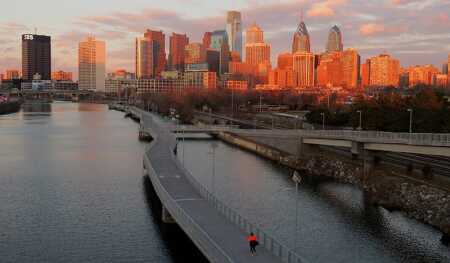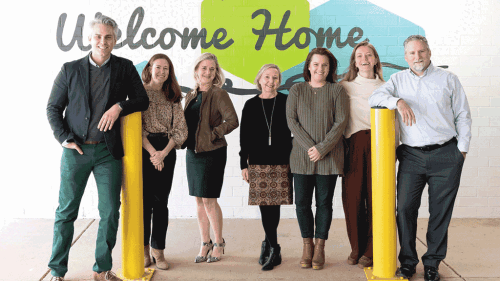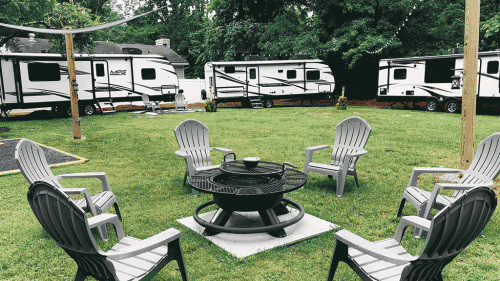Readers of USA Today recently voted the Schuylkill River Trail the best American urban trail. This designation broadly refers to the 10.5-mile (16.9 km) stretch of the trail that lies within Philadelphia’s city limits—and more specifically to the Center City section of the trail known as the Schuylkill Banks. That section includes a dramatic 2,000-foot (610 m) boardwalk, completed in October 2014, which runs above the river itself, since the space between the river and the adjoining CSX railroad tracks was too narrow to extend the trail on land.
The boardwalk is the latest accomplishment of the nonprofit Schuylkill River Development Corporation (SRDC), originally formed in 1992, then reorganized and reactivated in 2002. The SRDC arose out of a loose coalition of community groups and other stakeholders, including neighborhood advocates; West Philadelphia institutions such as the University of Pennsylvania, Drexel University, and Children’s Hospital of Philadelphia; industries abutting the river such as PECO, which is the local electric utility, and CSX railroad; and developers, including Brandywine Realty Trust (BRT), which develops and manages office and mixed-use space, including the César Pelli–designed Cira Centre and other properties in the immediate vicinity.
Related: Register for the 2016 ULI Spring Meeting in Philadelphia | Tours: Bikes, Boathouses, and a Boardwalk
Gerard H. Sweeney, BRT’s president and CEO, is also the chairman of the SRDC. He emphasized that the SRDC’s success is based on that collaboration of stakeholders, along with the city and state. “The groups came into alignment to create a public space that could serve as a neighborhood amenity,” Sweeney said. “There was a simultaneous recognition, on the part of both residents and major corporations, that this area of the city needed to be developed.”
The Schuylkill Banks project is part of a 26-mile (42 km) trail extending from Center City Philadelphia northwestward to Valley Forge. This trail, popular with bikers, runners, walkers, and strollers, is itself part of a larger project: the full Schuylkill River Trail will ultimately extend about 130 miles (209 km) from the Appalachian Trail in Schuylkill County down to where the Schuylkill flows into the Delaware River.
Most of the Schuylkill Trail within Philadelphia city limits is on land owned by the city and managed by the Philadelphia Parks and Recreation (PP&R) department. The northern stretch runs through Fairmount Park, which has been parkland since the mid–19th century. The southern section, the Schuylkill Banks, has been industrial just as long—it covers the tidal section of the river, extending from below the dam at the Fairmount Water Works to the mouth of the river. The SRDC is responsible for the ongoing transformation of this postindustrial section of the trail, which is owned by the city and managed by a partnership between PP&R and the SRDC.
Land acquisition for the Schuylkill Banks has been fairly straightforward so far—most of the land used already belonged to the city, or the city was able to obtain the needed easements. The section yet to be improved is mostly privately owned—but since a city ordinance prohibits new construction within 50 feet (15 m) of the river, it is of limited use for construction. (The addition of a trail within that border, however, can make the rest of the lot more valuable.) Ideally, the SRDC, in partnership with the city, will be able to obtain outright donations of the riverside real estate; the second-best scenario would be to arrange for easements while leaving it in private hands. If necessary, the SRDC will purchase the land; the use of eminent domain would be a last resort.
Once rights to the land have been obtained, improvements can begin, starting with remediation: most of the land is a brownfield. These projects are not cheap, and they require fiscal dexterity on the SRDC’s part to put together grants, many of which require matching funds, from federal, state, city, and private sources. The $19 million for the Boardwalk project came from a mix of federal, state, and city funding, including $6.2 million from a Transportation Investment Generating Economic Recovery (TIGER) stimulus grant and $3.9 million from a federal Congestion Mitigation/Air Quality (CMAQ) grant. The next section of the trail to be built—Bartram’s Mile—has an estimated cost of $7.5 million, of which about half is coming from private foundations and half from the city of Philadelphia and the state’s department of transportation. This section, which will link a portion of the west bank to the eastern portion of the river trail, broke ground in November of 2015, with construction projected for 2016.
Maintenance of the completed sections is shared between the SRDC and PP&R, with PP&R performing “ordinary” maintenance (turf mowing and snow removal; litter removal; trail repair) and the SRDC taking on “extraordinary” maintenance (turf aeration, seeding, and fertilizing; planting and maintenance of plant beds; leaf removal; graffiti removal). The SRDC spent about $140,000 for these tasks in 2014.
The success of Schuylkill Banks, Sweeney says, is due to “a small, dedicated cadre of people who live and breathe the trail, including a very diverse, very engaged board.” He singled out Joseph Syrnick, SRDC president and CEO, who plays a crucial role in getting things done. For his part, Syrnick stressed the importance of expanding the team as new groups, such as the Bicycle Coalition of Greater Philadelphia, emerge. “Young people especially, with their reach on social media, have played a crucial role” in generating and maintaining community engagement, he said. Providing programming—Riverfest, boat and kayak tours, movies, yoga classes—keeps the community involved even when pauses occur between capital projects.
Today, the SRDC can point to “a proven track record that makes it a little easier—it’s never easy—to talk to funding sources,” Sweeney said. He stressed that such an ambitious trail project can happen only when institutional and commercial development occur in tandem: “It could be problematic to get too far out in front with the trail without the accompanying development, as it would be very isolated and underutilized,” he said.
Developer Carl Dranoff has seen that tandem development up close. He was one of the first to begin developing the area now adjacent to Schuylkill Banks, transforming warehouse space to the Locust Point lofts back in 1984. In 1998, he did another luxury loft rehab, Locust on the Park, though, as he points out, the park was not yet built. “Public and private investment reinforce each other,” he said. “It’s circular: what makes a park safe and enjoyable is people.” His latest project, One Riverside, has just begun construction: the modernist tower will house baby boomers and others in luxury condos overlooking, and immediately adjacent to, the Schuylkill Banks trail.








